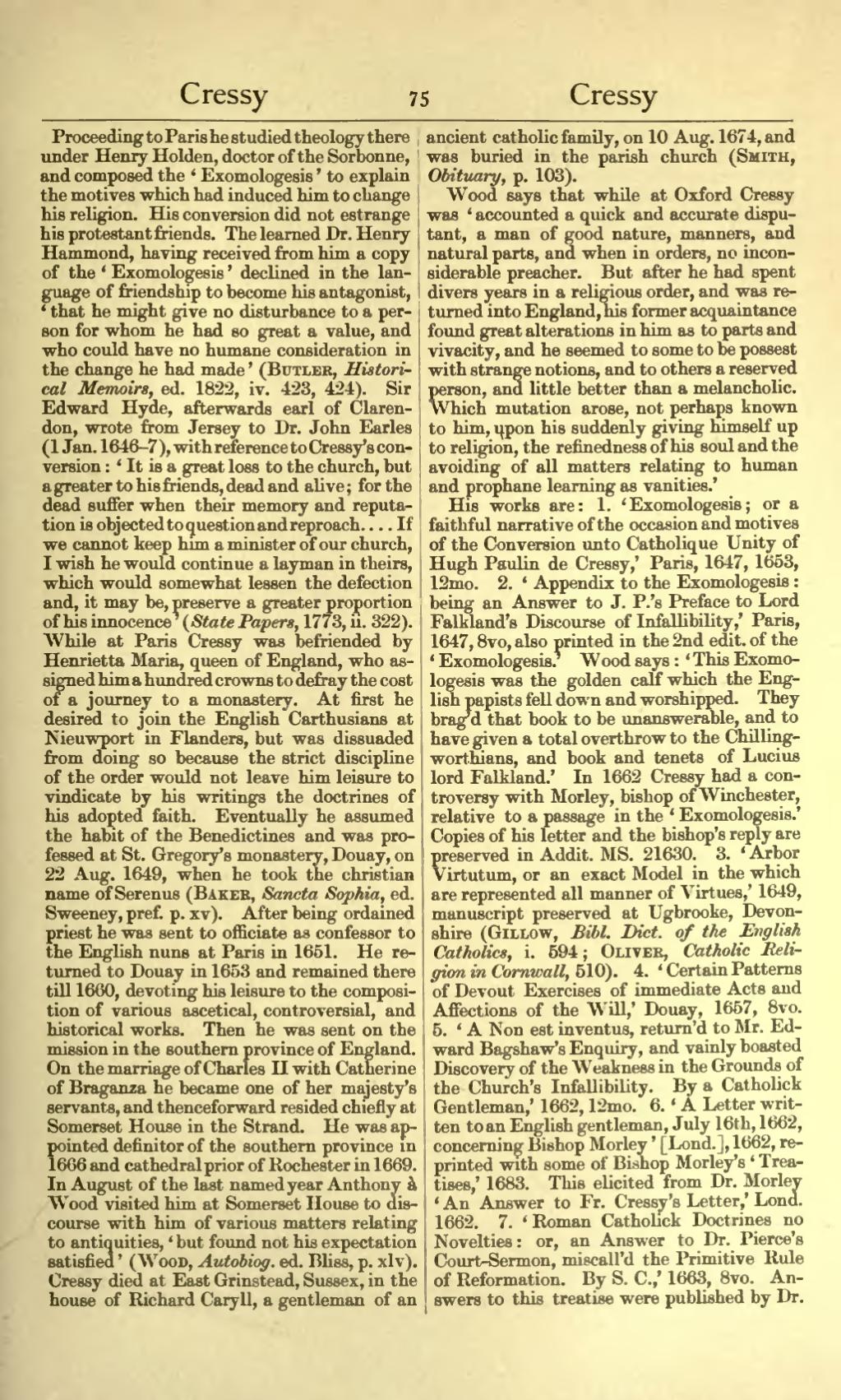Proceeding to Paris he studied theology there under Henry Holden, doctor of the Sorbonne, and composed the ‘Exomologesis’ to explain the motives which had induced him to change his religion. His conversion did not estrange his protestant friends. The learned Dr. Henry Hammond, having received from him a copy of the ‘Exomologesis’ declined in the language of friendship to become his antagonist, ‘that he might give no disturbance to a person for whom he had so great a value, and who could have no humane consideration in the change he had made’ (Butler, Historical Memoirs, ed. 1822, iv. 423, 424). Sir Edward Hyde, afterwards earl of Clarendon, wrote from Jersey to Dr. John Earles (1 Jan. 1646–7), with reference to Cressy's conversion: ‘It is a great loss to the church, but a greater to his friends, dead and alive; for the dead suffer when their memory and reputation is objected to question and reproach. … If we cannot keep him a minister of our church, I wish he would continue a layman in theirs, which would somewhat lessen the defection and, it may be, preserve a greater proportion of his innocence’ (State Papers, 1773, ii. 322). While at Paris Cressy was befriended by Henrietta Maria, queen of England, who assigned him a hundred crowns to defray the cost of a journey to a monastery. At first he desired to join the English Carthusians at Nieuwport in Flanders, but was dissuaded from doing so because the strict discipline of the order would not leave him leisure to vindicate by his writings the doctrines of his adopted faith. Eventually he assumed the habit of the Benedictines and was professed at St. Gregory's monastery, Douay, on 22 Aug. 1649, when he took the christian name of Serenus (Baker, Sancta Sophia, ed. Sweeney, pref. p. xv). After being ordained priest he was sent to officiate as confessor to the English nuns at Paris in 1651. He returned to Douay in 1653 and remained there till 1660, devoting his leisure to the composition of various ascetical, controversial, and historical works. Then he was sent on the mission in the southern province of England. On the marriage of Charles II with Catherine of Braganza he became one of her majesty's servants, and thenceforward resided chiefly at Somerset House in the Strand. He was appointed definitor of the southern province in 1666 and cathedral prior of Rochester in 1669. In August of the last named year Anthony à Wood visited him at Somerset House to discourse with him of various matters relating to antiquities, ‘but found not his expectation satisfied’ (Wood, Autobiog. ed. Bliss, p. xlv). Cressy died at East Grinstead, Sussex, in the house of Richard Caryll, a gentleman of an ancient catholic family, on 10 Aug. 1674, and was buried in the parish church (Smith, Obituary, p. 103).
Wood says that while at Oxford Cressy was ‘accounted a quick and accurate disputant, a man of good nature, manners, and natural parts, and when in orders, no inconsiderable preacher. But after he had spent divers years in a religious order, and was returned into England, his former acquaintance found great alterations in him as to parts and vivacity, and he seemed to some to be possest with strange notions, and to others a reserved person, and little better than a melancholic. Which mutation arose, not perhaps known to him, upon his suddenly giving himself up to religion, the refinedness of his soul and the avoiding of all matters relating to human and prophane learning as vanities.’
His works are: 1. ‘Exomologesis; or a faithful narrative of the occasion and motives of the Conversion unto Catholique Unity of Hugh Paulin de Cressy,’ Paris, 1647, 1653, 12mo. 2. ‘Appendix to the Exomologesis: being an Answer to J. P.'s Preface to Lord Falkland's Discourse of Infallibility,’ Paris, 1647, 8vo, also printed in the 2nd edit. of the ‘Exomologesis.’ Wood says: ‘This Exomologesis was the golden calf which the English papists fell down and worshipped. They brag'd that book to be unanswerable, and to have given a total overthrow to the Chillingworthians, and book and tenets of Lucius lord Falkland.’ In 1662 Cressy had a controversy with Morley, bishop of Winchester, relative to a passage in the ‘Exomologesis.’ Copies of his letter and the bishop's reply are preserved in Addit. MS. 21630. 3. ‘Arbor Virtutum, or an exact Model in the which are represented all manner of Virtues,’ 1649, manuscript preserved at Ugbrooke, Devonshire (Gillow, Bibl. Dict. of the English Catholics, i. 594; Oliver, Catholic Religion in Cornwall, 510). 4. ‘Certain Patterns of Devout Exercises of immediate Acts and Affections of the Will,’ Douay, 1657, 8vo. 5. ‘A Non est inventus, return'd to Mr. Edward Bagshaw's Enquiry, and vainly boasted Discovery of the Weakness in the Grounds of the Church's Infallibility. By a Catholick Gentleman,’ 1662, 12mo. 6. ‘A Letter written to an English gentleman, July 16th, 1662, concerning Bishop Morley’ [Lond.], 1662, reprinted with some of Bishop Morley's ‘Treatises,’ 1683. This elicited from Dr. Morley ‘An Answer to Fr. Cressy's Letter,’ Lond. 1662. 7. ‘Roman Catholick Doctrines no Novelties: or, an Answer to Dr. Pierce's Court-Sermon, miscall'd the Primitive Rule of Reformation. By S. C.,’ 1663, 8vo. Answers to this treatise were published by Dr.
